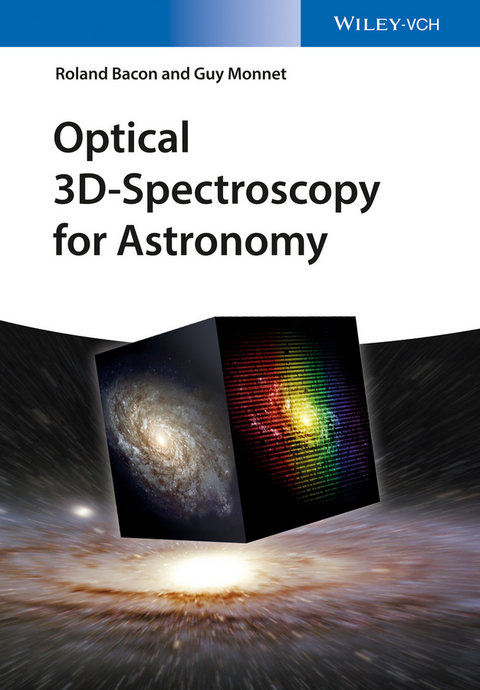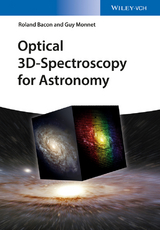Optical 3D-Spectroscopy for Astronomy
Wiley-VCH (Verlag)
978-3-527-41202-0 (ISBN)
Roland Bacon is astrophysicist, directeur de recherche au CNRS and former director of the Lyon Observatory (1994-2004). He has played a pioneering role in the development of integral field spectroscopy as leader of 4 major and innovative instruments for ground based telescope: TIGER and OASIS at the 3.6m Canada France Hawaii telescope, SAURON at the 4.2m William Herschel telescope and MUSE at the 8m ESO Very Large Telescope. His main research field is extragalactic astronomy. He is the owner since 2014 of an advanced grant from the European Research Commission. Guy Monnet is an astrophysicist, with 50-year experience of developing astronomical instrumentation, on the ground and in space, mostly with a 3D spectroscopic flavor. Successively, he was director of the Marseilles Observatory, Lyon Observatory and the Canada France Hawaii Telescope Corporation. He then took the position of Head of Instrumentation at the European Southern Observatory (1995-2009) and the Australian Astrophysical Observatory (2010-2011). His main scientific domain is the dynamics of stars and ionized gas in galaxies.
1 Introduction
Part 1: 3D Instrumentation
2 The Spectroscopic Toolbox
2.1 Basic Spectroscopic Principles
2.2 Optics & Coatings
2.3 Detectors
2.4 Interferometers
2.5 Dispersers
2.6 Mechanics & Cryogenics, Electronics
2.7 Management, Timeline & Cost
2.8 Exercises
3 Scanning Spectrographs
3.1 Scanning Long--Slit Spectrograph
3.2 Scanning Fabry--Perot Spectrograph
3.3 Scanning Fourier Transform Spectrograph
3.4 Exercises
4 Integral Field Spectrographs
4.1 Lenslet--based Integral Field Spectrograph
4.2 Fiber--based Integral Field Spectrograph
4.3 Slicer--based Integral Field Spectrograph
4.4 Exercises
5 New Trends in Integral Field Spectroscopy
5.1 Deployable Multi--object Integral Field Spectrograph
5.2 Paving the Field: parallel replicated Instruments
5.3 An Example: Autopsy of the MUSE wide--field Spectrograph
5.4 Exercises
6 Future Trends in 3D Spectroscopy
6.1 Photonics--based Spectrographs
6.2 Quest for the Grail: towards 3D Detectors
6.3 Exercises
Part 2: Using 3D Spectroscopy
7 Data Properties
7.1 Data Sampling
7.2 Noise Properties
8 Impact of Atmospheric Turbulence
8.1 Basic Principles
8.2 Seeing--limited Observations
8.3 Adaptive Optics Observations
8.4 Space--based Observations
9 Data Gathering
9.1 Planning Observations
9.2 Estimating Observing Time
9.3 Observing Strategy
10 Data Reduction
10.1 Basics
10.2 Specific Cases
11 Data Analysis
11.1 Kinematics
11.2 Spectrophotometry
11.3 Crowded Fields
11.4 Faint Point--like Sources
11.5 Faint Surface brightness Sources
11.6 Spatial Deconvolution
11.7 High Contrast Imaging
12 Conclusions
Bibliography
Annex 1: Hints to Exercises
| Erscheinungsdatum | 13.04.2017 |
|---|---|
| Verlagsort | Weinheim |
| Sprache | englisch |
| Maße | 170 x 244 mm |
| Gewicht | 790 g |
| Themenwelt | Sachbuch/Ratgeber ► Natur / Technik ► Weltraum / Astronomie |
| Naturwissenschaften ► Chemie | |
| Naturwissenschaften ► Physik / Astronomie ► Astronomie / Astrophysik | |
| Naturwissenschaften ► Physik / Astronomie ► Optik | |
| Technik ► Elektrotechnik / Energietechnik | |
| Schlagworte | Astronomie • Astronomie u. Astrophysik • Astronomy & Astrophysics • Astronomy & Astrophysics • Astrophysik • Chemie • Chemistry • earth sciences • Fernerkundung • Geowissenschaften • GIS & Remote Sensing • GIS & Remote Sensing • GIS u. Fernerkundung • Physics • Physik • spectroscopy • Spektroskopie |
| ISBN-10 | 3-527-41202-6 / 3527412026 |
| ISBN-13 | 978-3-527-41202-0 / 9783527412020 |
| Zustand | Neuware |
| Haben Sie eine Frage zum Produkt? |
aus dem Bereich





